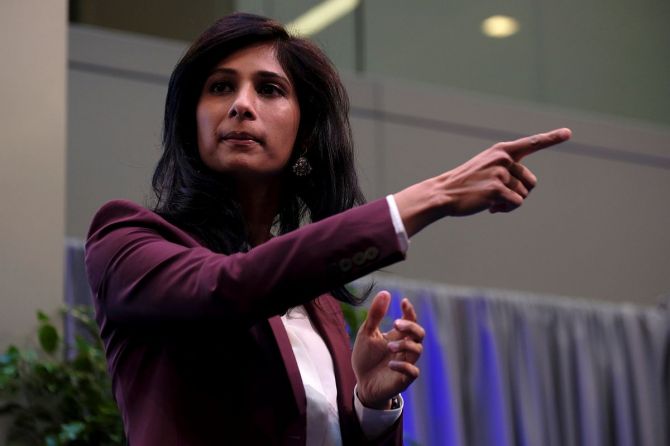'High-frequency indicators for Q3 continued to gain strength, suggesting a further recovery in economic activity.'

International Monetary Fund Chief Economist Gita Gopinath tells Indivjal Dhasmana high-frequency indicators for the third quarter of 2021 indicate momentum in economic recovery in India.
The IMF has stuck to its July forecast of economic growth for India but the lead indicators which came after its July report, such as the index of industrial production, core industries' output, tax collection, and the purchasing managers' index for manufacturing and services, do suggest economic recovery is on the upswing. Your take?
In July, we revised growth down from 12.5 per cent to 9.5 per cent in FY22 because downside risks were materialising due to the sharp surge in Covid-19 cases and as more broad-based lockdown measures were introduced.
Q1FY22 GDP, released at the end of August, came in slightly weaker than expected.
At the same time, high-frequency indicators for Q3 continued to gain strength, suggesting a further recovery in economic activity.
Our annual forecast, which remains unchanged, reflects such quarterly growth dynamics.
The government says the vaccination of all adults will happen in the current calendar year. Does this give you the confidence to say the Indian economy will grow faster than projected by the IMF?
India has made commendable progress on vaccination.
The vaccination rate accelerated through the summer.
Quicker progress could help contain the spread and impact of the pandemic.
A faster near-term rebound in demand could help improve the medium-term outlook.
India recently batted for a ratings upgrade. However, Moody's Investors Service upgraded only its outlook on sovereign ratings. Do you think India has a case for a ratings upgrade in the near future?
We don't comment on the rating actions by a specific credit-rating agency.
Looking ahead, steadfast implementation of the government's structural reforms announced can support productivity and medium-term growth potential.
Furthermore, a credible and clearly communicated medium-term fiscal consolidation strategy that outlines a gradual removal of exceptional policy support and revenue-enhancing measures can give policymakers greater means to respond to spending needs and support fiscal sustainability, and also improve the ratings outlook.
The IMF said risks to global economic prospects had increased and policy trade-offs had become more complex. In that context, does lowering the global growth projection by only 0.1 percentage point to 5.9 per cent for the current calendar year by the IMF not reflect a bit of optimism?
GDP growth in 2021H1 was broadly in line with expectations, despite slowing momentum in the second quarter due to the spread of infections and supply disruptions.
The modest headline revision of –0.1 percentage point, however, masks large downgrades for some countries.
The outlook for the low-income developing country group has darkened considerably.
The downgrade also reflects more difficult near-term prospects for the advanced economy group, in part due to widespread supply disruption.
Partially offsetting these changes, projections for some commodity exporters have been upgraded on the back of rising commodity prices.
Why did the IMF say that inflation risks are tilted towards the upside?
Inflation has increased in many countries, though in different degrees.
In most countries, rising inflation reflects base effects from very low levels a year ago, pandemic-related shortages of goods due to supply disruption amid rising demand, and higher commodity prices.
However, although inflation is expected to subside in 2022, risks to this inflation outlook are skewed towards the upside.
These risks could materialise if pandemic-induced shortages of goods and commodity supply relative to demand continue longer than expected.
The IMF said employment across the globe was generally expected to continue lagging the recovery in output. When is it expected that employment generation will reach pre-pandemic levels?
The labour market recovery is under way, but progressing very unevenly across countries and groups of workers.
Employment in large parts of the world remains below its pre-pandemic levels.
Workers in emerging market and developing economies (EMDEs), especially women, have been hit harder than in advanced economies, and within countries, youth and lower-skilled workers were more affected than others in terms of employment losses.
Only 70 per cent of the EMDEs are projected to regain the pre-crisis employment level by end-2022.
By 2024, employment in EMDEs is projected to remain 3 per cent below the level projected before the pandemic, holding back their growth potential.













 © 2025
© 2025